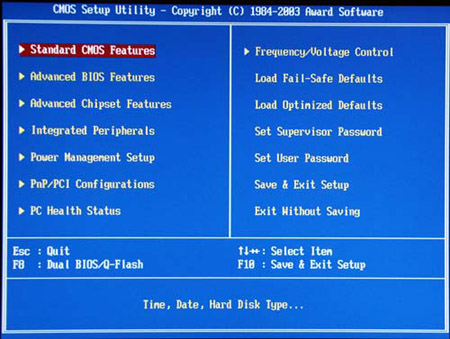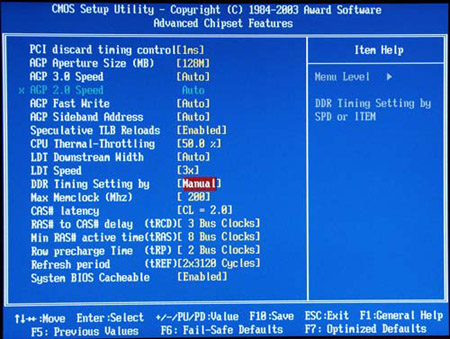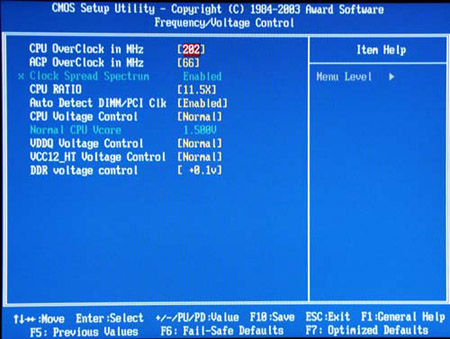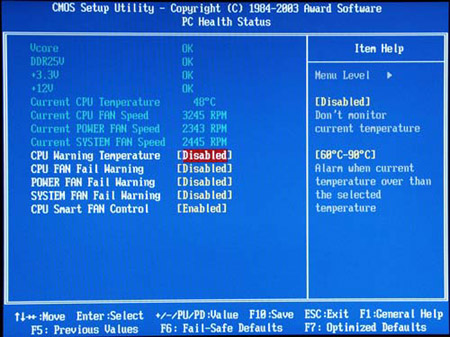Gigabyte K8NNXP-940: Built on Athlon64 FX51 Strengths
by Wesley Fink on October 9, 2003 11:52 PM EST- Posted in
- Motherboards
Gigabyte K8NNXP-940: BIOS and Overclocking
When we first looked at the Gigabyte pre-release BIOS, we were frankly disappointed. The board did not yield much better performance than the Athlon64 boards we had tested and it was missing the multiplier-unlocking feature. What a difference when we received the shipping F1 BIOS, which managed dramatic leaps in performance and the best Multiplier or Ratio settings that we have seen on an Athlon64 FX board. Considering that this is the first “release” version of the Gigabyte BIOS, we are looking forward to what additional performance Gigabyte may be able to coax from this board in future BIOS revisions.
The K8NNXP-940 uses the familiar Award BIOS, though it will take us all a while to get used to the new options available on HyperTransport boards. Gigabyte also leaves memory timings off their basic BIOS screen, as they have on other recently-released boards.

The Advanced Chipset Features are there — hidden — and you have to enter BIOS with DEL, then hit CTRL+F1 to bring up the hidden menu. We understand why Gigabyte might choose to do this on mainstream boards, but no one would ever accuse the expensive FX51, which requires expensive Registered memory, of being a mainstream choice. Users who will buy the K8NNXP-940 are enthusiasts, and they hardly need to be protected from themselves with a hidden memory timings menu. Gigabyte really needs to rethink this annoying feature, because all it does is create confusion.

Once you have found the Advanced Chipset Features, you will see a complete selection of memory-tweaking options. The LDT option allows changing Hypertransport speed, and we suggest you leave it alone. When we set LDT to 4.0 (800/1600), it promptly locked the system on reboot. Memory can be left at Auto, which reads the SPD and sets timings, or you can force a memory speed of 100, 133, 150, 166, or 200 representing DDR200 to DDR400.

Advanced BIOS Features is a collection of the more common BIOS controls. After initial setup, you will likely see this menu only if you have multiple boot devices, and need to make changes to Boot Order.

The Frequency/Voltage Control section is where CPU FSB (actually HT speed), CPU multipliers and voltages are set. You can also set AGP/PCI speed in 1MHz increments from 66 to 100. The available voltage options and ranges are what we expect, but have rarely found, on FX boards. We only wish Gigabyte had provided a wider range of DIMM voltage options. Considering FX51 only supports Registered or better memory, the range to +.3V may turn out to be perfectly acceptable. It is too early to determine at this point.

The F1 Release BIOS adds a full range of multipliers to the BIOS options. AMD users have been accustomed to being able to squeeze performance from their chips by changing ratios on the latest Athlon XP/Barton chips. Since Athlon64 did away with unlocked processors, AMD is wise to bring them back to the Athlon64 FX51 "Enthusiast" processor. It adds a bit more value to one of the most expensive CPUs on the market.
vCore or CPU voltage can be set to an unusual range of 0.8V to 1.70V. This may seem to be a strange range, but current 1.45V to 1.5V chips are likely the highest voltage that we will see in production chips, so the range is designed for the future. With Socket 940 due to be replaced with a Socket 939 that does support regular unbuffered memory, we wonder what this really represents in future-proofing. As some have pointed out, Socket 940 will continue for quite a while after FX as an Opteron standard.

PC Health Status gives a complete display of voltages, temperatures and fan speeds. Feelings are mixed, though, on the “OK” output in the voltage section. Computer Enthusiasts, the target market for this board, would really prefer to see real voltage readouts.
Overall, the BIOS options for the Gigabyte K8NNXP-940 are what we hoped we would see in FX motherboards. Until now, we weren't so sure that we would find this range of tweaking options on the new Athlon64 FX boards. Gigabyte and nVidia have delivered a board with the kinds of control that most Enthusiasts want. Some areas could be improved, but most will find the BIOS options for K8NNXP-940 to be a good selection to squeeze the best performance from their FX processor.










35 Comments
View All Comments
Anonymous User - Friday, October 10, 2003 - link
64-bit tests running Linux and hand-compiled programs would be:a) Really time consuming
b) Artificial
c) Not relevant to the real world
Anonymous User - Friday, October 10, 2003 - link
It is odd that NO 64-bit tests has been made. Why don't people fire up Linux and compile a few programs like MPEG encoding, video/divx processing etc etc?Anonymous User - Friday, October 10, 2003 - link
Has anyone tried decreasing both the memory speed and the LDT speed when overclocking an athlon 64 board via the fsb?The reason I ask is that being able to set the memory, and hypertransport ratio's, may make an independant CPU multiplier adjusment redundant.
(obviously it would be nice to rule CPU frequency out of such a test)
PrinceGaz - Friday, October 10, 2003 - link
...almost forgot, why was the P4EE 3.2 not included in the benchmarks?PrinceGaz - Friday, October 10, 2003 - link
Very very nice board and CPU, and impressive benchmarks throughout (you can't expect it to match the P4 for encoding). But next year's 939-pin FX is definitely the one to wait for.#4- QDR is just as unlikely as RDRAM but for different reasons, a key point of the A64/FX is the on-die memory-controller but that means you can't just add another couple of memory-channels to it without a total socket re-design (and for QDR a ridicoulously high pin-count). DDR2 is the way forwards in the future rather than more channels.
I'd really expected the fastest CPU nearly two years after getting my XP1700+ to be more than just 85% or so faster than it (the Barton 3200+ is barely over 50% faster, and the A64 3200+ about 70% faster). Unfortunately I can't justify an upgrade until its over 2x, preferably 3x as fast so I'll wait into next year and see what speed increases the shift to 90nm brings.
Anonymous User - Friday, October 10, 2003 - link
Very impressive board, We've used Gigabyte boards almost exclusively for the past few years at our computer shop and they just keep getting better with every revision. What I'm looking forward to is what they're going to have coming out early next year for the FX, by that time, having an FX system will become a reality for those of us who can't pay an arm and a testes.Anonymous User - Friday, October 10, 2003 - link
I want to know whats up with Gunmetal. Otherwise, great review. I just hope that the prices come down, alot, by spring for my upgrade.Anonymous User - Friday, October 10, 2003 - link
If anyone had doubts about the A64 and FX performance there should be no questions now!FX is intended to satisfy the extreme demands of power users who want the best and they want it now. A64 is a more cost effective solution for those who want outstanding performance at a consumer price point.
As A64/FX ramp all prices will drop as is normal. You'll likely find that the FX series is quite affordable to the enthusiast market and a Helleva value as things ramp.
And there are some more goodies on the way from AMD and it's partners to make all consumers very happy. Stay tuned!
Wesley Fink - Friday, October 10, 2003 - link
#5 - Regular Opterons are locked - at least that is what we found in the 2 we tested. The FX is unlocked.#6 - Yes, this is the first 1394b 800mb/sec Firewire board.
mcveigh - Friday, October 10, 2003 - link
is this the first PC board with firewire800?